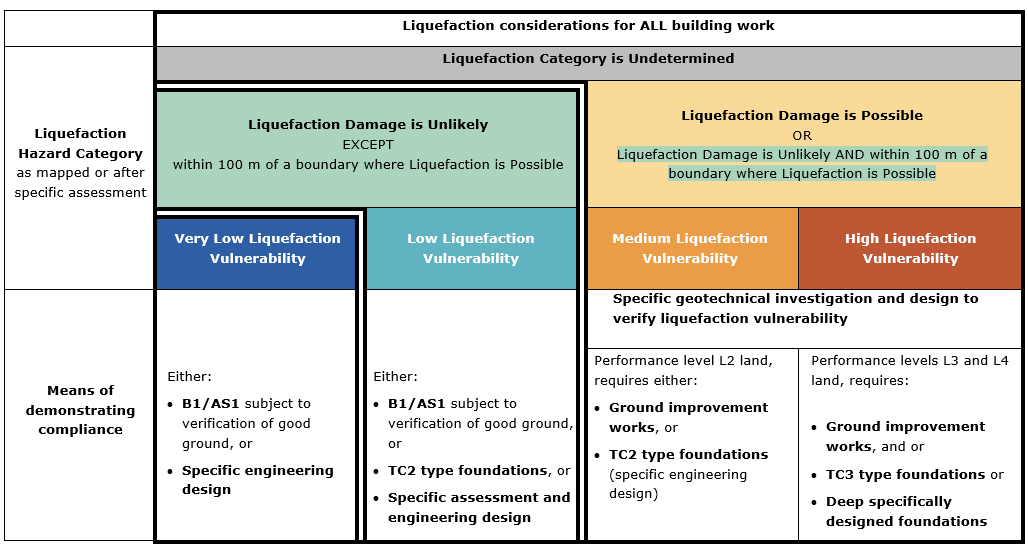New buildings and liquefaction effects
Ensuring new buildings can withstand liquefaction effects
Changes from the November 2019 Building Code update will ensure new buildings are built safe and strong enough to withstand liquefaction effects. Foundations for houses built on ground that has the potential for liquefaction or lateral spread are now outside the scope of B1/AS1 and NZS3604.
These changes came into effect on 29 November 2021. The change was made as a result of the experience of the Canterbury earthquakes, and subsequent recommendations made by the Royal Commission of Inquiry.
An in-depth summary of the changes is provided on MBIE’s web page: Ensuring new buildings can withstand liquefaction effects
How do I know if my property is within an area that is potentially susceptible to liquefaction?
Our understanding of liquefaction in Nelson continues to evolve as new areas are assessed and we undertake more detailed studies in areas known to be susceptible to liquefaction. Click here to find out about liquefaction assessments that have been undertaken in the Nelson region, and to see the latest mapping of areas where liquefaction is possible. Please note that to determine the specific liquefaction hazard affecting any individual site or property, a site-specific assessment may need to be undertaken.
What does this mean if my property is within an area that is potentially vulnerable to liquefaction?
You are not required to do anything to your existing building, or if you are carrying out building works that are:
- minor internal alterations that do not significantly load existing foundations and do not require new foundations, or
- minor footprint extensions for lightweight residential buildings
What does this mean if I’m considering building work?
An assessment to ascertain ‘good ground’ or specific investigation and design, as applicable, is still required. Owners and Designers should now also:
- make reasonable enquiry to satisfy themselves that the mapped site vulnerability category is accurate. This would typically include at least shallow investigation in accordance with Section 2.4.4.1 of the NZGS/MBIE Module 2 Geotechnical Investigations for Earthquake Engineering, and
- consider specifying a more robust foundation where ground performance is less certain.
Although changing a building’s use may not involve building work, consideration of liquefaction is required where it is proposed to change a building’s use.
A helpful guide to achieve Building Code compliance
All building consent applications which nominate B1/AS1 as a compliance pathway must include supporting evidence to show that either liquefaction damage is not likely or has a low probability of occurrence. Regardless of compliance pathway, it is the applicant’s responsibility to provide evidence. The table below and the regional liquefaction mapping can help you with this.
To use the table:
- Select the liquefaction hazard category that matches the mapped category at your building site
- Look down the column within the heavier borders to see what options you have to demonstrate compliance

Notes:
- TC1 to TC3 refer to the ground foundation technical category for land set out in MBIEs Canterbury Guidance Part A Technical Guidance (TC1 and TC2) and Part C Assessing, repairing and rebuilding foundations in TC3. The geotechnical requirements for these are set out in Table 5.2. The Technical Guidance is part of a package of information available at Repairing and rebuilding houses affected by the Canterbury earthquakes
- Ground performance levels L1 to L5 refer to the level of land damage expected from a design seismic event as set out in Earthquake Geotechnical Engineering Module 3- Identification, assessment and mitigation of liquefaction hazards.
- Geotechnical investigations for foundation design should be undertaken in accordance with Earthquake Geotechnical Engineering Module 2 – Geotechnical Investigations for Earthquake Engineering
- Council will not require that liquefaction assessments be supplied for proposed buildings that meet all of the following criteria:
- importance level 1 (low consequence of failure, non-habitable) as set out in NZS1170.0 clause 3.3
- lightweight construction less than 40 m2
- height is no more than 4 m
- is at least its own height from a property boundary and
- is at least its own height from another building with importance level 2 or greater
Performance requirements of the Building Code will still need to be met.
What does it mean if I’m applying for subdivision resource consent?
There is a requirement to assess significant risk from natural hazards, including liquefaction when applying for Subdivision Resource Consent.
